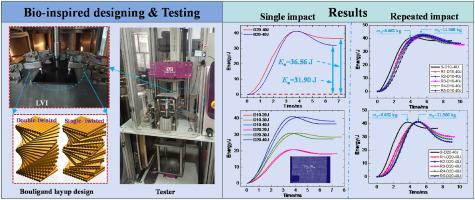Single and repeated low-velocity impact response of CFRP laminates with bioinspired double-helicoidal Bouligand structures
IF 9.8
1区 材料科学
Q1 MATERIALS SCIENCE, COMPOSITES
引用次数: 0
Abstract
It is challenging to improve the impact resistance of carbon fiber-reinforced polymer (CFRP), especially in the situation of repeated impacts. This paper reports on the improvement of energy-absorption characteristic and impact resistance of CFRP laminates by using Bouligand-type biomimetic architecture. Three types of specimens, quasi-isotropic (QI), single-twisted (SB) and double-twisted (DB) Bouligand-type laminates, were fabricated and tested with single and 5-time repeated low velocity impact (LVI) experiments under impact energy ranging from 20J to 40J. Meanwhile, a validated finite element (FE) model and ultrasonic C-scan technique were utilized to study the interlaminar damage and energy absorption capacity associated with the impact response. Experimental results indicated that DB outperform QI and SB in terms of specific energy absorption (SEA) and peak impact load. After 5-time repeated impacts the DB with 10° pitch angle enable to retain about 97 % in energy absorption capacity, whereas those with 20° pitch angle exhibited the energy absorption capacity reduction of about 14 % and local structural failure. Furthermore, the effects of pitch angle and impactor mass on the impact resistance of DB was numerically examined. A pitch angle of 5° results in an improvement of up to 10 % in resistance compared to those with 10° and 22.5° pitch angles, and at 40J impact energy a lighter high-speed impactor contributes to obtain a more dispersed damage distribution that presents petal-shaped, resulting improved impact resistance.

仿生双螺旋布利甘结构CFRP复合材料的单次和重复低速冲击响应
提高碳纤维增强聚合物(CFRP)的抗冲击性是一项具有挑战性的工作,特别是在反复冲击的情况下。本文报道了采用bouligand型仿生结构改善CFRP复合材料吸能性能和抗冲击性能。制作了准各向同性(QI)、单扭(SB)和双扭(DB) bouligand型层压板3种类型的试样,并在冲击能量为20J ~ 40J的情况下进行了单次和5次重复低速冲击(LVI)试验。同时,利用验证的有限元模型和超声c扫描技术研究了与冲击响应相关的层间损伤和能量吸收能力。实验结果表明,DB在比能量吸收(SEA)和峰值冲击负荷方面优于QI和SB。经5次反复撞击后,10°俯仰角结构的吸能能力保持在97%左右,而20°俯仰角结构的吸能能力下降14%左右,并出现局部结构破坏。此外,还对俯仰角和冲击器质量对DB抗冲击性能的影响进行了数值分析。与俯仰角为10°和22.5°的冲击器相比,俯仰角为5°的冲击器的阻力提高了10%,在40J的冲击能量下,较轻的高速冲击器有助于获得更分散的花瓣状损伤分布,从而提高了抗冲击性。
本文章由计算机程序翻译,如有差异,请以英文原文为准。
求助全文
约1分钟内获得全文
求助全文
来源期刊

Composites Science and Technology
工程技术-材料科学:复合
CiteScore
16.20
自引率
9.90%
发文量
611
审稿时长
33 days
期刊介绍:
Composites Science and Technology publishes refereed original articles on the fundamental and applied science of engineering composites. The focus of this journal is on polymeric matrix composites with reinforcements/fillers ranging from nano- to macro-scale. CSTE encourages manuscripts reporting unique, innovative contributions to the physics, chemistry, materials science and applied mechanics aspects of advanced composites.
Besides traditional fiber reinforced composites, novel composites with significant potential for engineering applications are encouraged.
 求助内容:
求助内容: 应助结果提醒方式:
应助结果提醒方式:


